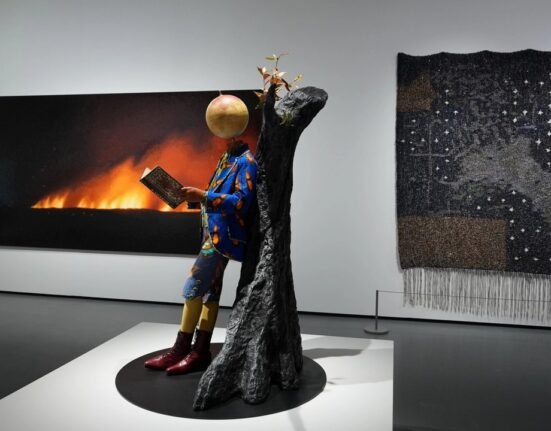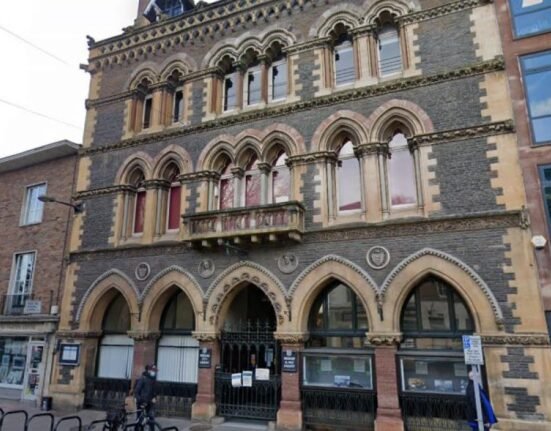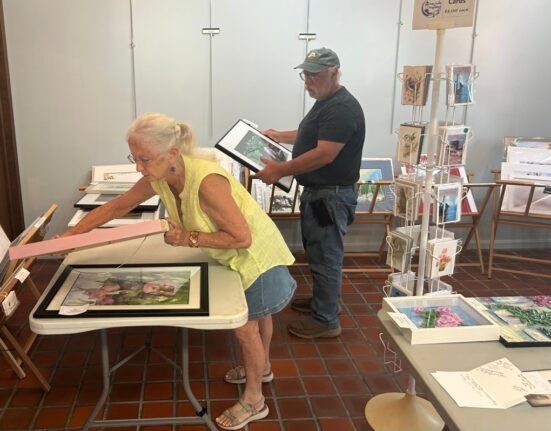SALEM — “Making History,” the immodest title of a somewhat more modest exhibition newly opened at the Peabody Essex Museum, promises much and delivers some of it. Gleaned from the considerable collection of the Pennsylvania Academy of Fine Arts are 86 works by American artists across eras and generations, some wildly famous and many not at all so. What’s more American than make or break?
Past the marquee names — Winslow Homer, Alice Neel, Georgia O’Keeffe, Andrew Wyeth, Stuart Davis — a theme emerges; or should I say, is driven home? “Making America” isn’t subtle and can feel simplistic in its corrective effort to wedge neglected branches of American art history into a canon that’s still too narrow. Even so, it’s a worthy cause, especially this weekend, as America looks at itself and tries to decide if it likes what it sees. “Making History” is a reminder that the American Experiment is a forever-unfinished work in progress, and offers a broader base to build on.
PAFA, in Philadephia, has its own story to tell, too. Established in 1805, it was one of the first academies to admit women and Black artists. “Making art is a process of making history,” a block of text on the wall proclaims; in national mythmaking, artists matter. “Making History,” with fewer than 100 pieces, can’t offer much more than a skim of a complex and fractious national narrative still being fought over — and maybe never more than right now — but it’s a meaningful one.

In the first gallery, competing visions of an uneasy country rub up against each other: Benjamin West’s “Penn’s Treaty with the Indians,” 1771–72, a shining vision of revisionist history — colonists kneeling before their Indigenous hosts in gratitude and respect — shares space with Horace Pippin’s “John Brown Going to His Hanging,” 1942, and Alice Neel’s “Investigation of Poverty at the Russell Sage Foundation,” 1933.
Myth, meet reality: West’s beatific scene was painted a century after the British colonist William Penn’s 1682 land transfer agreement with the Lenape people. In 1737, his son Thomas would devise a ploy to take vast tracts of Lenape land; no surprise, then, that it was Thomas who commissioned the painting, a public-image recovery effort, with the wealth gained from his birthright larceny.

The painting’s golden glow further tarnishes against its gallery mates. Neel’s, a dun and gloomy scene of Depression-era suffering — the woman at the frame’s center, Neel wrote, was living in an overturned car in New York with her seven children — is an unflinching document of urban poverty. Pippin’s, dense, claustrophobic and bleak, depicts the final moments of the firebrand abolitionist John Brown, who tried to mount an anti-enslavement revolt in 1859. Pippin, who was Black, was also self-taught, making his inclusion in the esteemed Academy collection all the more poignant.
Painters like West have long been pillars of the canon; for generations, they held it up on their own. Recent years have seen a broader, more enlightened view begin to inflect its standard fare. Examples are many and close at hand, from the Museum of Fine Arts’ holistic reinstallation of its American collection in 2023 to Harvard Art Museum’s “Reframe” initiative in 2021 to PEM’s own “On This Ground: Being and Belonging in America,” an integration of its colonial and Indigenous American collections launched in 2022.

That display is just downstairs, and withers “Making History” a little by comparison; fuller and more deliberate, the stories it unpacks are a model of what a museum collection should look like in this fractious moment. “Making History,” as a traveling show, feels more general and rootless, because it is. And though it can feel like supplementary reading, there’s a richness not to be ignored.
Mid-exhibition, it labors a little; Charles Willson Peale’s “The Artist in His Museum,” 1822, a self-portrait of the PAFA founder literally raising a curtain on the many wonders of the collection he’s assembled, is a gesture of self-aggrandizing pride. It lifts the veil, if you’ll pardon the pun, on early museum-making as a practice of pilfering, rounding up exotic bits from far-flung cultures deemed as primitive as a gesture of dominance and ownership — critical for a young nation’s sense of itself. I would have liked to see that explored — indeed, the exhibition is begging for it — but Peale’s self-portrait is paired with a 1977 self-portait by Joan Brown, same-scaled and similarly self-declarative, which makes another very valid point about the exclusion of women from the American canon.

But the show comes to life in other matchups: Gilbert Stuart’s iconic “George Washington (The Lansdowne Portrait),” 1796, sharing space with portraits by contemporary Black painters James Brantley and Barkley Hendricks. There are so many ways to go with this — Washington, paragon of freedom, crafting a nation of freedom denied to both men’s ancestors, for one — but let’s stick with the pictures. Stuart’s portrait has the sheen of stiff aristocratic hagiography — Thomas Gainsborough and the British Royals, say — with the ornamentation of Republican Rome, the classical democratic ideal. Brantley paints himself in shadow — “Brother James,” 1968 — wrapped in a grimy American flag; he had just returned from the war in Vietnam, waged in the name of a freedom far from ideal. Hendricks, meanwhile, is just cool, cool, cool — his “J. S. B. III,” 1968, has a relaxed and confident swagger, an avatar for the frank depictions of self-possessed Black subjects to which he devoted his painting life. The counterpoint he makes with Washington is just as powerful as Brantley’s: He meets fusty myth with the indomitable joy of his own now.
The show is never quite so socially powerful and vibrant as it is right here — its apex, come too soon. From there, we follow what’s essentially a long denouement, through old favorites and themes of quotidian American life and on to the landscape — inseparable, city or countryside, from the nation’s self-imagining. Myth pervades here, too — Homer’s beloved “Fox Hunt,” 1893, with its red fox struggling through snow to evade hungry crows, an allegory of the elemental cycle of life and death — and nudges up against the anxiety of modern progress. Nearby, Childe Hassam’s “The Hovel and the Skyscraper,” 1904, captures rapid, inexorable change: From his apartment window on the Upper West Side, construction scaffolding frames a riding stable in the near distance — soon, you can guess, not to be.
I would have loved to linger long and more deeply on this theme, bound up as it is in every aspect of American history and art. There’s a continuum hinted at, but unexplored: From the Hudson River School with its simplistic — and incomplete — paeans to God’s own wilderness to Charles Sheeler’s 1920s and ’30s paintings of American industry, crisp and steely (he’s here, but with an unexpected 1936 painting of tightly clustered clapboard exteriors and cedar-shingled roofs), and on to the pervasive big-box and parking lot landscape of the mid- to later-20th century captured by photographers like Stephen Shore and his confreres in the New Topographics school.
More friction means more truth, not to mention a better story. “Making History” hints at frictions, but mostly defers. Its deference is largely in favor of beauty, I’ll give it that. I’ll never turn down a chance to see the soft focus of an Arthur Dove landscape, more feeling than fact, and his “Naples Yellow Morning,” 1935, loose and dreamy, is pure pleasure. But pleasure is far too easy, and especially right now. History is being rewritten as we speak. Don’t look away.
MAKING HISTORY: 200 YEARS OF AMERICAN ART FROM THE PENNSYLVANIA ACADEMY OF THE FINE ARTS
At Peabody Essex Museum, 161 Essex St., Salem. Through Sept. 21. 978-745-9500, PEM.org.
Murray Whyte can be reached at murray.whyte@globe.com. Follow him @TheMurrayWhyte.







